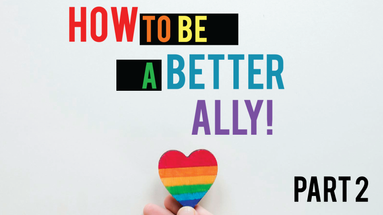Posted by John on Aug 6th 2020
How to be a Better Ally, Part 2: Breaking the Binary
How To Be a Better Ally (Table of Contents)
Part 1: What Does Being an Ally Mean?
Part 2: Breaking the Binary (current)
Part 3: History of Pride (next)
Part 4: Pride Flags
Part 5: Things You Can Do
Breaking the Binary
As humans, we like control, and there’s no greater control than building a system by which you can accurately identify things. Systems of black or white, yes or no, known as binary systems, are one of our preferred methods for classifying because they are so simple.
You may be tempted to think of things like gender and sexuality as binary, but you’d be wrong. But don’t fret, it’s not your fault for thinking that way. In fact, lots of people have thought that way for a very long time (binary reference).
Examples of binary thinking:
- Straight or Gay
- Masculine or Feminine
- Male or Female
And don’t be fooled into thinking “spectrums” are any different. They are just variations of the binary, but still binary based.
Examples of spectrums:
- Straight <--> Gay
- Masculine <--> Feminine
- Male <--> Female
Instead, try to think of each individual part of a person as a lever. Each lever controls just one identity, with variations from “super-strongly exhibits this identity” to “very barely exhibits it”. Now, let’s try those examples above as levers.
- Attraction to women 0 - 100
- Attraction to men 0 - 100
- Masculinity 0 - 100
- Femininity 0 - 100
- Maleness 0 - 100
- Femaleness 0 - 11
This makes each identity independent of others. Just because you are masculine doesn’t mean you can’t be feminine as well. Just because you like women doesn’t mean you can’t like men as well. So on.
Sam Killermann (he/him) does a great job of explaining this in his book, “A Guide To Gender: The Social Justice Advocate's Handbook” using the Genderbread Person Model. He’s released the model as open-source so you can check it out on his website at https://guidetogender.com/.
Recap: Does That Make Sense?
In the end, our main goal from this section is that you walk away realizing (perhaps for the first time) that gender, identity and sexuality are fluid and independent of each other; the presence of one does not dictate the absence of another. Instead, each identity/gender/sexuality acts as a single ingredient in the makeup of who you are.
This also means that some of the terms you are familiar with are slightly outdated or not as accurate as they could be. For instance, “lesbian” usually means a woman (not a man) who is sexually attracted to women (but not men). Now that we realize things like “masculinity” and gender and attraction are individual parts, we also know that being a “woman” or “being sexually attracted to women” are somewhat of a simplification, don’t you think?
That being said, you’re going to see some (possibly) new words in the next chapter that might challenge the binary way you may have thought of things in the past.
If it’s still unclear, don’t worry! It’s not a straightforward topic, so understanding it isn’t always straightforward, either. Go back and give this section a second glance, or continue on and circle back when you finish. It never hurts to read it a few times to truly absorb the content.
Want to download the full PDF of "How To Be a Better Ally" for free?
Just sign up for our mailing list below!

